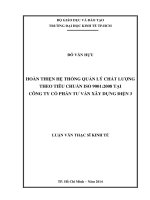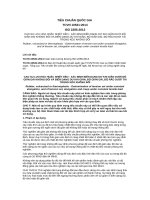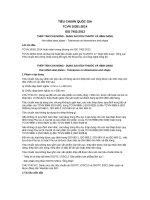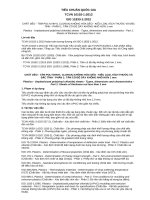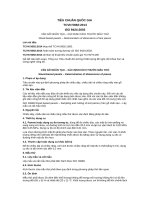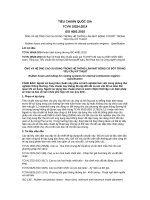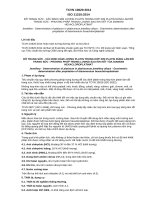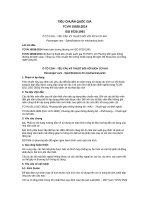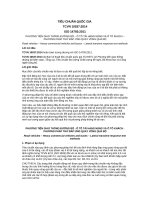Tiêu chuẩn iso ieee 11073 10102 2014
Bạn đang xem bản rút gọn của tài liệu. Xem và tải ngay bản đầy đủ của tài liệu tại đây (2.89 MB, 194 trang )
INTERNATIONAL
ISO/IEEE
STANDARD
11073-10102
First edition
2014-03-01
Health informatics — Point-of-care
medical device communication —
Part 10102:
Nomenclature — Annotated ECG
Informatique de santé — Communication entre dispositifs médicaux sur
le site des soins
Partie 10102: Nomenclature — ECG annoté
Reference number
ISO/IEEE 11073-10102:2013(E)
© IEEE 2013
ISO/IEEE 11073-10102:2014(E)
PDF disclaimer
This PDF file may contain embedded typefaces. In accordance with Adobe's licensing policy, this file may be printed or viewed but
shall not be edited unless the typefaces which are embedded are licensed to and installed on the computer performing the editing. In
downloading this file, parties accept therein the responsibility of not infringing Adobe's licensing policy. Neither the ISO Central
Secretariat nor IEEE accepts any liability in this area.
Adobe is a trademark of Adobe Systems Incorporated.
Details of the software products used to create this PDF file can be found in the General Info relative to the file; the PDF-creation
parameters were optimized for printing. Every care has been taken to ensure that the file is suitable for use by ISO member bodies
and IEEE members. In the unlikely event that a problem relating to it is found, please inform the ISO Central Secretariat or IEEE at the
address given below.
COPYRIGHT PROTECTED DOCUMENT
© ISO 2014
© IEEE 2013
All rights reserved. Unless otherwise specified, no part of this publication may be reproduced or utilized in any form or by any means,
electronic or mechanical, including photocopying and microfilm, without permission in writing from either ISO or IEEE at the respective
address below.
ISO copyright office
Case postale 56 CH-1211 Geneva 20
Tel. + 41 22 749 01 11
Fax + 41 22 749 09 47
Web www.iso.org
Institute of Electrical and Electronics Engineers, Inc.
3 Park Avenue, New York NY 10016-5997, USA
Web www.ieee.org
ISO version published 2013
Published in Switzerland
ii
© IEEE 2013 – All rights reserved
ISO/IEEE 11073-10102:2014(E)
Foreword
ISO (the International Organization for Standardization) is a worldwide federation of national standards bodies
(ISO member bodies). The work of preparing International Standards is normally carried out through ISO
technical committees. Each member body interested in a subject for which a technical committee has been
established has the right to be represented on that committee. International organizations, governmental and
non-governmental, in liaison with ISO, also take part in the work. ISO collaborates closely with the International
Electrotechnical Commission (IEC) on all matters of electrotechnical standardization.
IEEE Standards documents are developed within the IEEE Societies and the Standards Coordinating
Committees of the IEEE Standards Association (IEEE-SA) Standards Board. The IEEE develops its standards
through a consensus development process, approved by the American National Standards Institute, which
brings together volunteers representing varied viewpoints and interests to achieve the final product. Volunteers
are not necessarily members of the Institute and serve without compensation. While the IEEE administers the
process and establishes rules to promote fairness in the consensus development process, the IEEE does not
independently evaluate, test, or verify the accuracy of any of the information contained in its standards.
The main task of technical committees is to prepare International Standards. Draft International Standards
adopted by the technical committees are circulated to the member bodies for voting. Publication as an
International Standard requires approval by at least 75 % of the member bodies casting a vote.
Attention is called to the possibility that implementation of this standard may require the use of subject matter
covered by patent rights. By publication of this standard, no position is taken with respect to the existence or
validity of any patent rights in connection therewith. ISO/IEEE is not responsible for identifying essential
patents or patent claims for which a license may be required, for conducting inquiries into the legal validity or
scope of patents or patent claims or determining whether any licensing terms or conditions provided in
connection with submission of a Letter of Assurance or a Patent Statement and Licensing Declaration Form, if
any, or in any licensing agreements are reasonable or non-discriminatory. Users of this standard are expressly
advised that determination of the validity of any patent rights, and the risk of infringement of such rights, is
entirely their own responsibility. Further information may be obtained from ISO or the IEEE Standards
Association.
ISO/IEEE 11073-10102 was prepared by the Substations Committee of the IEEE Power Engineering Society
of the IEEE (as IEEE 1686-2007). It was adopted by Technical Committee ISO/TC 215, Lung ventilators, in
parallel with its approval by the ISO member bodies, under the “fast-track procedure” defined in the Partner
Standards Development Organization cooperation agreement between ISO and IEEE. IEEE is responsible for
the maintenance of this document with participation and input from ISO member bodies.
ISO/IEEE 11073 consists of the following parts, under the general title Health informatics — Personal health
device communication (text in parentheses gives a variant of subtitle):
Part 00103: Overview
Part 10101: (Point-of-care medical device communication) Nomenclature
Part 10102: (Point-of-care medical device communication) Nomenclature — Annotated ECG
Part 10103: (Point-of-care medical device communication) — Nomenclature — Implantable device,
cardiac
Part 10201: (Point-of-care medical device communication) Domain information model
Part 10404: Device specialization — Pulse oximeter
© IEEE 2013 – All rights reserved
iii
ISO/IEEE 11073-10102:2014(E)
Part 10406: Device specialization — Basic electrocardiograph (ECG) (1- to 3-lead ECG)
Part 10407: Device specialization — Blood pressure monitor
Part 10408: Device specialization — Thermometer
Part 10415: Device specialization — Weighing scale
Part 10417: Device specialization — Glucose meter
Part 10418: Device specialization — International Normalized Ratio (INR) monitor
Part 10420: Device specialization — Body composition analyzer
Part 10421: Device specialization — Peak expiratory flow monitor (peak flow)
Part 10441: Device specialization — Cardiovascular fitness and activity monitor
Part 10471: Device specialization — Independant living activity hub
Part 10472: Device specialization — Medication monitor
Part 20101: (Point-of-care medical device communication) Application profiles — Base standard
Part 20601: Application profile — Optimized exchange protocol
Part 30200: (Point-of-care medical device communication) Transport profile — Cable connected
Part 30300: (Point-of-care medical device communication) Transport profile — Infrared wireless
Part 30400: (Point-of-care medical device communication) Interface profile — Cabled Ethernet
Part 90101: (Point-of-care medical device communication) Analytical instruments — Point-of-care test
Part 91064: (Standard communication protocol) Computer-assisted electrocardiography
Part 92001: (Medical waveform format) — Encoding rules
iv
© IEEE 2013 – All rights reserved
Health informatics—Point-of-care medical device communication
Part 10102: Nomenclature—Annotated ECG
IEEE Engineering in Medicine and Biology Society
Sponsored by the
IEEE 11073™ Standards Committee
IEEE
3 Park Avenue
New York, NY 10016-5997
USA
15 February 2013
IEEE Std 11073-10102™-2012
IEEE Std 11073-10102TM-2012
ISO/IEEE 11073-10102:2014(E)
Health informatics—Point-of-care medical device communication
Part 10102: Nomenclature—Annotated ECG
Sponsor
IEEE 11073TM Standards Committee
of the
IEEE Engineering in Medicine and Biology Society
Approved 5 December 2012
IEEE-SA Standards Board
ISO/IEEE 11073-10102:2014(E)
Abstract: The base IEEE 11073 -10101 Nomenclature is extended by this st andard to provide
support for ECG annotation terminology. It ma y be used eit her in conjunction with other
IEEE 11073 standards (e.g., ISO/IEEE 11073-10201:2001) or independently with other
standards. The major subject areas addressed by the no menclature include ECG beat
annotations, wave component annotations, rhythm annotations, and noise annotations. Additional
“global” and “per-lead” numeric observation identifiers, ECG lead systems, and additional ECG
lead identifiers also are defined.
Keywords: annotated ECG, annotations, arrhythmias, cardiac rhythm, codes, ECG leads, ECG
lead systems, ECG m easurements, home monitori ng, IEEE 11073-10102 TM, medical device
communication, nomenclature, pacemaker, patient monitoring, remote monitoring, terminology
•
The Institute of Electrical and Electronics Engineers, Inc.
3 Park Avenue, New York, NY 10016-5997, USA
Copyright © 2013 by The Institute of Electrical and Electronics Engineers, Inc.
All rights reserved. Published 15 February 2013. Printed in the United States of America.
IEEE is a registered trademark in the U.S. Patent & Trademark Office, owned by The Institute of Electrical and Electronics
Engineers, Incorporated.
EASI is a trademark in the U.S. Patent & Trademark Office, owned by the Philips Electronics North America Corporation.
PDF:
Print:
ISBN 978-0-7381-8156-1
ISBN 978-0-7381-8157-8
STD98104
STDPD98104
IEEE prohibits discrimination, harassment, and bullying. For more information, visit />
No part of this publication may be reproduced in any form, in an electronic retrieval system or otherwise, without the prior written permission
of the publisher.
ii
Copyright © 2013 IEEE. All rights reserved.
ISO/IEEE 11073-10102:2014(E)
Notice and Disclaimer of Liability Concerning the Use of IEEE Documents: IEEE Standards documents are developed
within the IEEE Societies and the Standards Coordinating Committees of the IEEE Standards Association (IEEE-SA)
Standards Board. IEEE develops its standards through a consensus development process, approved by the American National
Standards Institute, which brings together volunteers representing varied viewpoints and interests to achieve the final product.
Volunteers are not necessarily members of the Institute and serve without compensation. While IEEE administers the process
and establishes rules to promote fairness in the consensus development process, IEEE does not independently evaluate, test, or
verify the accuracy of any of the information or the soundness of any judgments contained in its standards.
Use of an IEEE Standard is wholly voluntary. IEEE disclaims liability for any personal injury, property or other damage, of
any nature whatsoever, whether special, indirect, consequential, or compensatory, directly or indirectly resulting from the
publication, use of, or reliance upon any IEEE Standard document.
IEEE does not warrant or represent the accuracy or content of the material contained in its standards, and expressly disclaims
any express or implied warranty, including any implied warranty of merchantability or fitness for a specific purpose, or that
the use of the material contained in its standards is free from patent infringement. IEEE Standards documents are supplied "AS
IS."
The existence of an IEEE Standard does not imply that there are no other ways to produce, test, measure, purchase, market, or
provide other goods and services related to the scope of the IEEE standard. Furthermore, the viewpoint expressed at the time a
standard is approved and issued is subject to change brought about through developments in the state of the art and comments
received from users of the standard. Every IEEE standard is subjected to review at least every ten years. When a document is
more than ten years old and has not undergone a revision process, it is reasonable to conclude that its contents, although still of
some value, do not wholly reflect the present state of the art. Users are cautioned to check to determine that they have the
latest edition of any IEEE standard.
In publishing and making its standards available, IEEE is not suggesting or rendering professional or other services for, or on
behalf of, any person or entity. Nor is IEEE undertaking to perform any duty owed by any other person or entity to another.
Any person utilizing any IEEE Standards document, should rely upon his or her own independent judgment in the exercise of
reasonable care in any given circumstances or, as appropriate, seek the advice of a competent professional in determining the
appropriateness of a given IEEE standard.
Translations: The IEEE consensus development process involves the review of documents in English only. In the event that
an IEEE standard is translated, only the English version published by IEEE should be considered the approved IEEE standard.
Official Statements: A statement, written or oral, that is not processed in accordance with the IEEE-SA Standards Board
Operations Manual shall not be considered the official position of IEEE or any of its committees and shall not be considered to
be, nor be relied upon as, a formal position of IEEE. At lectures, symposia, seminars, or educational courses, an individual
presenting information on IEEE standards shall make it clear that his or her views should be considered the personal views of
that individual rather than the formal position of IEEE.
Comments on Standards: Comments for revision of IEEE Standards documents are welcome from any interested party,
regardless of membership affiliation with IEEE. However, IEEE does not provide consulting information or advice pertaining
to IEEE Standards documents. Suggestions for changes in documents should be in the form of a proposed change of text,
together with appropriate supporting comments. Since IEEE standards represent a consensus of concerned interests, it is
important to ensure that any responses to comments and questions also receive the concurrence of a balance of interests. For
this reason, IEEE and the members of its societies and Standards Coordinating Committees are not able to provide an instant
response to comments or questions except in those cases where the matter has previously been addressed. Any person who
would like to participate in evaluating comments or revisions to an IEEE standard is welcome to join the relevant IEEE
working group at />Comments on standards should be submitted to the following address:
Secretary, IEEE-SA Standards Board
445 Hoes Lane
Piscataway, NJ 08854-4141
USA
Photocopies: Authorization to photocopy portions of any individual standard for internal or personal use is granted by The
Institute of Electrical and Electronics Engineers, Inc., provided that the appropriate fee is paid to Copyright Clearance Center.
To arrange for payment of licensing fee, please contact Copyright Clearance Center, Customer Service, 222 Rosewood Drive,
Danvers, MA 01923 USA; +1 978 750 8400. Permission to photocopy portions of any individual standard for educational
classroom use can also be obtained through the Copyright Clearance Center.
iii
Copyright © 2013 IEEE. All rights reserved.
ISO/IEEE 11073-10102:2014(E)
Notice to users
Laws and regulations
Users of IEEE Standards documents should consult all applicable laws and regulations. Compliance with
the provisions of any IEEE Standards document does not imply compliance to any applicable regulatory
requirements. Implementers of the standard are responsible for observing or referring to the applicable
regulatory requirements. IEEE does not, by the publication of its standards, intend to urge action that is not
in compliance with applicable laws, and these documents may not be construed as doing so.
Copyrights
This document is copyrighted by the IEEE. It is made available for a wide variety of both public and
private uses. These include both use, by reference, in laws and regulations, and use in private selfregulation, standardization, and the promotion of engineering practices and methods. By making this
document available for use and adoption by public authorities and private users, the IEEE does not waive
any rights in copyright to this document.
Updating of IEEE documents
Users of IEEE Standards documents should be aware that these documents may be superseded at any time
by the issuance of new editions or may be amended from time to time through the issuance of amendments,
corrigenda, or errata. An official IEEE document at any point in time consists of the current edition of the
document together with any amendments, corrigenda, or errata then in effect. In order to determine whether
a given document is the current edition and whether it has been amended through the issuance of
amendments, corrigenda, or errata, visit the IEEE-SA Website at or
contact the IEEE at the address listed previously. For more information about the IEEE Standards
Association or the IEEE standards development process, visit the IEEE-SA Website at
/>
Errata
Errata, if any, for this and all other standards can be accessed at the following URL:
Users are encouraged to check this URL for errata
periodically.
iv
Copyright © 2013 IEEE. All rights reserved.
ISO/IEEE 11073-10102:2014(E)
Patents
Attention is called to the possibility that implementation of this standard may require use of subject matter
covered by patent rights. By publication of this standard, no position is taken by the IEEE with respect to
the existence or validity of any patent rights in connection therewith. If a patent holder or patent applicant
has filed a statement of assurance via an Accepted Letter of Assurance, then the statement is listed on the
IEEE-SA Website Letters of Assurance may
indicate whether the Submitter is willing or unwilling to grant licenses under patent rights without
compensation or under reasonable rates, with reasonable terms and conditions that are demonstrably free of
any unfair discrimination to applicants desiring to obtain such licenses.
Essential Patent Claims may exist for which a Letter of Assurance has not been received. The IEEE is not
responsible for identifying Essential Patent Claims for which a license may be required, for conducting
inquiries into the legal validity or scope of Patents Claims, or determining whether any licensing terms or
conditions provided in connection with submission of a Letter of Assurance, if any, or in any licensing
agreements are reasonable or non-discriminatory. Users of this standard are expressly advised that
determination of the validity of any patent rights, and the risk of infringement of such rights, is entirely
their own responsibility. Further information may be obtained from the IEEE Standards Association.
v
Copyright © 2013 IEEE. All rights reserved.
ISO/IEEE 11073-10102:2014(E)
Introduction
This introduction is not part of IEEE Std 11073-10102-2012, Health informatics—Point-of-care medical device
communication—Nomenclature—Annotated ECG.
This standard extends the base ISO/IEEE 11073-10101:2004a nomenclature to provide support for
electrocardiogram (ECG) annotation terminology. The major subject areas addressed by the nomenclature
include ECG beat annotations, wave component annotations, rhythm annotations, and noise annotations. It
also defines additional “global” and “per-lead” numeric observation identifiers, ECG lead systems, and
additional ECG lead identifiers. The nomenclature extensions may be used in conjunction with other
IEEE 11073 standard components (e.g., ISO/IEEE 11073-10201:2004 [B19]b) or independently with other
standards.
a
b
Information on references can be found in Clause 2.
The numbers in brackets correspond to those in the bibliography in Annex E.
vi
Copyright © 2013 IEEE. All rights reserved.
ISO/IEEE 11073-10102:2014(E)
Contents
1. Overview .................................................................................................................................................... 1
1.1 Scope ................................................................................................................................................... 1
1.2 Purpose ................................................................................................................................................ 1
1.3 Audience .............................................................................................................................................. 2
1.4 Context ................................................................................................................................................ 2
2. Normative references.................................................................................................................................. 3
3. Definitions, acronyms, and abbreviations .................................................................................................. 3
3.1 Definitions ........................................................................................................................................... 3
3.2 Acronyms and abbreviations ............................................................................................................... 4
4. Introduction to IEEE Std 11073-10102 ...................................................................................................... 5
4.1 Clinical background ............................................................................................................................. 5
5. Nomenclature requirements ........................................................................................................................ 7
5.1 Overview ............................................................................................................................................. 7
5.2 Scope requirements.............................................................................................................................. 7
5.3 Organizational structure requirements ................................................................................................. 7
5.4 Semantic requirements......................................................................................................................... 7
5.5 Distribution format requirements......................................................................................................... 7
6. Nomenclature structure .............................................................................................................................. 8
7. Conformance .............................................................................................................................................. 8
8. Extensibility and versioning ..................................................................................................................... 10
Annex A (normative) Base terms ................................................................................................................. 11
Annex B (normative) Expanded terms and numeric codes .......................................................................... 68
Annex C (informative) Schema and XML for annotated ECG nomenclature .............................................. 92
Annex D (informative) Cross-references to other ECG standards .............................................................169
Annex E (informative) Bibliography ..........................................................................................................175
Annex F (infromative) IEEE list of participants .........................................................................................177
vii
Copyright © 2013 IEEE. All rights reserved.
ISO/IEEE 11073-10102:2014(E)
Health informatics—Point-of-care medical device communication
Part 10102: Nomenclature—Annotated ECG
IMPORTANT NOTICE: IEEE Standards documents are not intended to ensure safety, health, or
environmental protection, or ensure against interference with or from other devices or networks.
Implementers of IEEE Standards documents are responsible for determining and complying with all
appropriate safety, security, environmental, health, and interference protection practices and all
applicable laws and regulations.
This IEEE document is made available for use subject to important notices and legal disclaimers.
These notices and disclaimers appear in all publications containing this document and may
be found under the heading “Important Notice” or “Important Notices and Disclaimers
Concerning IEEE Documents.” They can also be obtained on request from IEEE or viewed at
/>
1. Overview
1.1 Scope
This standard extends the base ISO/IEEE 11073-10101:20041 to provide support for ECG annotation
terminology. Major subject areas addressed by the nomenclature include ECG beat annotations, wave
component annotations, rhythm annotations, and noise annotations. It also defines additional “global” and
“per-lead” numeric observation identifiers, ECG lead systems, and additional ECG lead identifiers. The
nomenclature extensions may be used in conjunction with other IEEE 11073 standard components (e.g.,
ISO/IEEE 11073-10201:2004 [B19]2) or independently with other standards.
1.2 Purpose
This standard provides a unified and comprehensive terminology for ECG annotation semantics, making it
suitable for medical device data exchange that requires inclusion of ECG annotations. This standard
consolidates numerous other standard and nonstandard terminologies that are in current use, resulting in the
harmonization of how ECG annotation information is identified, enabling interoperability, and providing
information exchange at the application level.
1
2
Information on references can be found in Clause 2.
The numbers in brackets correspond to those of the bibliography in Annex E.
1
Copyright © 2013 IEEE. All rights reserved.
ISO/IEEE 11073-10102:2014(E)
IEEE Std 11073-10102-2012
Health informatics—Point-of-care medical device communication
Part 10102: Nomenclature—Annotated ECG
Currently, many terminologies and protocols, both standard and vendor specific, are used to manage and
exchange ECG annotation information. As a result, protocol converters and translators are required to
integrate systems and applications, typically with some degree of semantic loss and noninteroperability.
This standard provides a single terminology that is capable of supporting applications that require ECG
annotations, including evaluation of patient condition (e.g., reviewing ECG data at the point-of-care or
remotely) as well as clinical research (e.g., electronically submitting clinical drug trial evidence supporting
the efficacy of a new medication). In addition to incorporating ECG annotations into an ISO/IEEE 11073based information stream acquired at the bedside, the underlying nomenclature can also be used in other
persistent and communication standards [e.g., Health Level Seven International (HL7) V2 and V3, and
Digital Imaging and Communications in Medicine (DICOM)] for use by various applications, including
clinical information systems, electronic patient records, and clinical research.
1.3 Audience
The audience for this document is those who work with monitoring and diagnostic ECG information in the
context of systems integration. This may include but is not limited to the following roles:
⎯ Cardiologist or electrophysiologist physicians
⎯ Heart and device clinic specialists or staff
⎯ Primary care physicians
⎯ Clinic information technologists
⎯ Clinic information system vendor engineers
⎯ Academic and clinical research scientists
⎯ Regulatory and quality management agencies
⎯ Clincal trial and research results reporting
⎯ Medical device and system development engineers
The following clinical applications are facilitated by this interoperability enabled by this standard. This
may include but is not limited to the following activities:
⎯ Clinical trial and research results reporting [HL7 annotated electrocardiogram (aECG), Clinical
Data Interchange Standards Consortium (CDISC), and others]
⎯ Transfer of ECG data in an interoperable manner [DICOM, HL7, IEEE 11073, Integrating the
Healthcare Enterprise Patient Care Devices (IHE PCD), and other communication protocols]
⎯ Algorithm development and performance evaluation
⎯ Sophisticated real-time data exchange with option to retrospectively review and correct data
1.4 Context
This nomenclature has been developed within the context of the broader ISO/IEEE 11073 Health
Informatics—Point-of-Care Medical Device Communication standards. Its goal is to be consistent with
existing 11073 standards and information models.
2
Copyright © 2013 IEEE. All rights reserved.
ISO/IEEE
IEEE Std 11073-10102-2012
Health informatics—Point-of-care medical device communication
Part 10102: Nomenclature—Annotated ECG
11073-10102:2014(E)
2. Normative references
The following referenced documents are indispensable for the application of this document (i.e., they must
be understood and used, so that each referenced document is cited in text and its relationship to this
document is explained). For dated references, only the edition cited applies. For undated references, the
latest edition of the referenced document (including any amendments or corrigenda) applies.
ANSI/AAMI EC71-2001,
Electrocardiography.3
Standard
Communications
Protocol
for
Computer
Assisted-
ISO/IEEE 11073-10101:2004, Health informatics—Point-of-care medical device communication—
Part 10101: Nomenclature.4
3. Definitions, acronyms, and abbreviations
3.1 Definitions
For the purposes of this document, the following terms and definitions apply. The IEEE Standards
Dictionary Online should be consulted for terms not defined in this clause.5
annotation: An observation made on or associated with a time series of events, typically at a specific point
in time or over an interval of time.
arrhythmia: Any abnormality of cardiac rhythm. Also termed “dysrhythmia.” Specific examples are
bradycardia, tachycardia, and ventricular fibrillation.
base term: A fundamental semantic concept.
cardiac monitor: A device that acquires and analyzes the electrical waveforms of the cardiovascular
system for measurement, display, and treatment.
cardiologist: Physician specializing in disorders of the heart.
co-constraint: A rule describing a constraint whose scope is inclusive of more than one term.
constraint: A restriction on the set of values being assigned.
control variable: In this nomenclature, an attribute that specifies some aspect of a device configuration,
setting, or the observation method.
discriminators: A mechanism to provide additional semantic refinement to multiple base terms.
domain information model (DIM): The model describing common concepts and relationships for a
problem domain.
3
ANSI publications are available from the American National Standards Institute ( />ISO/IEC publications are available from the ISO Central Secretariat ( ISO publications are also available in the
United States from the American National Standards Institute ( />5
The IEEE Standards Dictionary Online subscription is available at />standards_dictionary.html.
4
3
Copyright © 2013 IEEE. All rights reserved.
ISO/IEEE 11073-10102:2014(E)
IEEE Std 11073-10102-2012
Health informatics—Point-of-care medical device communication
Part 10102: Nomenclature—Annotated ECG
electrocardiogram (ECG): (A) A set of cardiac waveforms (leads) acquired over a contiguous period of
time. (B) Traditionally 12 waveforms (leads) representing 10 s of cardiac activity while the patient is lying
on his or her back at rest. It is the physical or electronic record of the patient’s cardiac activity produced by
an electrocardiograph.
electrocardiograph: A device that records the electrical activity of the patient’s heart by tracing voltage
versus time waveforms, either on paper or digitally.
electronic health records: A longitudinal collection of electronic health information about individual
patients or populations. It is a record in digital format that is capable of being shared within or across
different health care settings by being embedded in network-connected enterprise-wide information system.
electrophysiologist: A physician with advanced study of the electrical properties of the heart.
lead: A vector along which the heart’s electrical activity is recorded as a waveform, either as a single
“unipolar” lead with respect to a common reference voltage or as a “bipolar” lead that represents the
voltage difference measured at two different sites.
nomenclature: A set of names or terms comprising a taxonomy for a specific domain.
pacemaker: A small, battery-powered electrical impulse generator which is implanted in patients to
support or maintain heart rate. External pacemakers, typically used in a hospital setting, are also supported
by this nomenclature.
reference ID (REFID): A unique, symbolic, and programmatic form for the term. The form is correlated
to the context-free code (i.e., titles are by definition context-free with respect to all other titles); in this
standard, terms are typically prefixed with “MDC_ECG_” for consistency.
rhythm disturbance: An irregular heart beat or sequence of beats.
systematic name: An organization of differentiating, relational descriptors that are unique for each term.
terminology: A synonym for nomenclature.
3.2 Acronyms and abbreviations
aECG
CDISC
DICOM
DIM
ECG
HL7
ID
IDC
IDCO
IHE PCD
MDC
REFID
annotated electrocardiogram
Clinical Data Interchange Standards Consortium
Digital Imaging and Communications in Medicine
domain information model
electrocardiogram
Health Level Seven
identifier
implantable device cardiac
implantable device cardiac observation
Integrating the Healthcare Enterprise Patient Care Devices
medical device communication
IEEE 11073 reference identifier
4
Copyright © 2013 IEEE. All rights reserved.
ISO/IEEE
IEEE Std 11073-10102-2012
Health informatics—Point-of-care medical device communication
Part 10102: Nomenclature—Annotated ECG
11073-10102:2014(E)
4. Introduction to IEEE Std 11073-10102
The key objectives of this standard are as follows:
⎯ Define a set of annotation mnemonics to describe beat, wave component, rhythm, and noise
annotations to support detailed beat-by-beat information about the electrocardiogram.
⎯ Extend the existing IEEE 11073-10101 ECG lead identifiers, including the ability to indicate
“derived” leads for every “original” ECG lead.
⎯ Extend the existing IEEE 11073-10101 “per-lead” and “global” ECG measurement identifiers to
support the capabilities of contemporary 12-lead ECG analysis algorithms.
⎯ Add additional semantic concept groups the define ECG lead systems (predefined
configurations of multiple ECG leads) and control variables that specify ECG signal filter
characteristics.
⎯ Where possible, the nomenclature definitions should also support the following:
1) Cardiologist-friendly labels, compatible with present-day cardiac nomenclature
conventions, that can be used by clinicians when reviewing or editing annotated
waveforms. These should leverage existing nomenclatures, where appropriate.
2) ISO/IEEE 11073-10101 “programmer-friendly” reference identifiers, following
existing 11073 labeling conventions wherever possible, and assigning numeric codes to
each.
3) Equivalent mappings, where possible, with existing annotated databases and tools, such
as the MIT-BIH and PhysioNet annotated ECG databases.
The principal focus is beat and rhythm annotation, scalable from single-lead to 12-lead analysis, applicable
to standard and advanced 12-lead ECG, Holter, and patient monitoring applications. In other words, this
work extends the concepts typically used to describe simple rhythm monitoring to how a cardiologist would
annotate a continuous 12-lead ECG record.
4.1 Clinical background
Millions of people experience irregular heartbeats at some point in their lives. Some of these irregularities
may be due to cardiac rhythm disturbances (arrhythmias). Some arrhythmias are determined by medical
professionals to be relatively benign, whereas other arrhythmias can be associated with variable degrees of
clinical risk. There are certain more extreme cardiac rhythm disturbances that may be dangerous or even
fatal.
Arrhythmias are caused by disorders of the heart’s electrical system, which in a healthy state would
function to help coordinate synchronous and mechanically advantageous electrical activation of the cardiac
muscle. In the case of a cardiac arrhythmia, the heart rhythm may be too slow, too fast, or otherwise
chaotic; in some instances, different portions of the heart are activated in a dyssynchronous manner. In any
of these instances, functional efficiency of the heart suffers and cardiac performance may be significantly
impaired.
One of the first steps in monitoring patients who exhibit arrhythmias is to obtain the ECG signal using an
electrocardiograph to acquire a short-term (typically 10 s) electrocardiogram or acquiring the signal over
several days using a Holter recorder and analyzing it later on. An event recorder can also be used to acquire
and analyze the data and to save arrhythmia episodes considered important by the device’s algorithms.
More modern systems can combine long-term recording and real-time analysis and can upload the
5
Copyright © 2013 IEEE. All rights reserved.
ISO/IEEE 11073-10102:2014(E)
IEEE Std 11073-10102-2012
Health informatics—Point-of-care medical device communication
Part 10102: Nomenclature—Annotated ECG
information to a monitoring service, effectively combining the roles of real-time patient monitoring and
sophisticated analysis and review of the data.
Central to these applications is the accuracy of the algorithms used to detect and classify ECG beats and
rhythms. One of the most effective ways of documenting the algorithm output is to record each beat and
rhythm detected by the algorithm, since this information provides the clinician (as well as the algorithm
developer) a clear and unambiguous record of the analysis. The “beat-by-beat” and “rhythm-by-rhythm”
representation also can support powerful “retrospective” review and editing tools that can enhance the
accuracy of the final summary report. The corrections made on a retrospective data set can also be used to
“prospectively” reduce the likelihood making the same error in the future in a real-time monitoring system.
The goal of this nomenclature extension is to provide a standard nomenclature for ECG beats, rhythms, and
advanced diagnostic ECG measurements suitable for traditional 12-lead ECG analysis as well as for
systems that acquire and analyze a smaller number of leads. It extends the nomenclature developed for
earlier annotated data sets (e.g., MIT-BIH) by defining codes for more than 35 different beat types and
more than 75 rhythms, commensurate with advanced 12-lead diagnostic ECG acquisition and analysis,
acquired in the context of a traditional resting, stress, monitoring, telemetry, or long-term ambulatory ECG.
Figure 1 illustrates several of these ECG nomenclature components.
Alternatively stated, a very strong attempt has been made to extend the existing terminology defined by
ISO/IEEE 11073-10101:2004, ANSI/AAMI EC71-2001 [B7], and other standards to provide the message
semantics required to support advanced 12-lead ECG, short of defining a standardized terminology and
grammar for the summary diagnostic statement.
RHYTHM, NOISE
BEAT
P
QRS
T
Figure 1 —ECG rhythm, noise, beat, and wave components
6
Copyright © 2013 IEEE. All rights reserved.
ISO/IEEE
IEEE Std 11073-10102-2012
Health informatics—Point-of-care medical device communication
Part 10102: Nomenclature—Annotated ECG
11073-10102:2014(E)
5. Nomenclature requirements
5.1 Overview
The nomenclature in this standard defines normative text identifiers and numeric code identifiers for
labeling electrocardiographic data. Requirements are defined by subject domain and industry experts.
The requirements for the nomenclature fall into multiple categories, as follows:
⎯ The scope of the nomenclature
⎯ The organizational structure of the nomenclature
⎯ The semantics of the nomenclature
5.2 Scope requirements
The following requirements regarding the scope and content of the standard were used:
⎯ Level of detail shall be summary information as specified and understood by subject domain
experts
⎯ Shall only define terms that are common across domain
⎯ Shall allow for specific vendor enumerations of terms, if needed
5.3 Organizational structure requirements
The following requirements regarding the organization structure of the standard were used:
⎯ Term identifiers shall be organized in a consistent hierarchical classification scheme
⎯ Terms should be organized to minimize the need for postcoordination of multiple terms to
define commonly used observation identifiers or concepts
5.4 Semantic requirements
The following requirements regarding the semantic definitions were used:
⎯ Domain and industry experts will discuss and define term semantic requirements.
5.5 Distribution format requirements
The following requirements regarding the distribution format were used:
⎯ The nomenclature shall be made available in a computable representation to facilitate
incorporation into protocols, devices, systems, and message conformance test tools.
7
Copyright © 2013 IEEE. All rights reserved.
ISO/IEEE 11073-10102:2014(E)
IEEE Std 11073-10102-2012
Health informatics—Point-of-care medical device communication
Part 10102: Nomenclature—Annotated ECG
6. Nomenclature structure
The nomenclature in this standard is structured based on a hierarchical taxonomy. The base root node is
MDC_ECG, which is short for Medical Device Communication—ECG. The MDC_ECG nomenclature
term codes are assigned numeric codes that extend the existing set of ECG terms in the ISO/IEEE 11073
SCADA partition [PART=2] as well in a new partition [PART=10] allocated for advanced ECG terms.
The principal MDC_ECG terminology groups are listed in Table 1.
Discriminators are used to provide additional semantic refinement that can be applied to multiple terms.
Discriminators are used to manage complexity within the nomenclature hierarchy and to promote
uniformity of like-kind detailed semantic concepts.
A term is uniquely identified by a Reference ID, Systematic Name, and Code according to the scheme
described in ISO/IEEE 11073-10101:2004. A term’s Reference ID consists of following a sequential path
through the nomenclature hierarchy from the root semantic concept to a leaf semantic concept. Each node
on this path becomes a component of the term’s Reference ID and Systematic Name, and it appropriately
represents the semantic of the term.
After expanding all discriminators, a unique numeric code [CODE10] is assigned to each term from a
16-bit partition [PART] in which the term resides. A 32-bit “context free” numeric code [CF_CODE10] for
each term is calculated by computing the sum of (65536 × PART) + CODE10 + any applicable
discriminators.
7. Conformance
Conformance to definitions in this standard is specified primarily at the appropriate application or system
interface. It is expected that this standard will be referenced by other healthcare systems integration
standards or profiles that define specific applications of the nomenclature.
8
Copyright © 2013 IEEE. All rights reserved.
ISO/IEEE
IEEE Std 11073-10102-2012
Health informatics—Point-of-care medical device communication
Part 10102: Nomenclature—Annotated ECG
11073-10102:2014(E)
Table 1 —Principal MDC_ECG terminology groups
Top level
MDC_ECG_LEAD_
MDC_ECG_WAVC_
MDC_ECG_WAVP_
MDC_ECG_BEAT_
MDC_ECG_RHY_
MDC_ECG_NOISE_
MDC_ECG_ global
MDC_ECG_ per Lead
MDC_ECG_LDSYS_
MDC_ECG_CTL_VBL_
MDC_ECG_ info attr
Terminology groups
ECG leads (implemented as an eight-bit discriminator)
ECG wave components
Normal wave components
Composite wave components
Abnormal wave components
Segments
ST measurement
Miscellaneous
ECG wave pacemaker components
Antibradycardia pace
Antitachycardia pace
Cardioversion (low-energy shock)
Defibrillation (high-energy shock)
ECG beats
Nonspecific beats
Supraventricular extrasystole
Ventricular extrasystole
Escape beats
Intraventricular block
ECG rhythms
Sinus rhythm
Sinus arrhythmia (originating from the SA node)
Atrial ectopic rhythm (atrial sites other than the SA node)
Supraventricular (atrial or junctional) ectopic rhythms
AV junctional rhythms
Atrioventricular block and dissociation
Sino-atrial exit block
Ventricular ectopic rhythms
Ventricular pre-excitation (WPW) rhythm
Implanted pacemaker rhythm
Pause
Miscellaneous ECG rhythms and other interval events
Pacemaker stimuli that were expected but are missing
ECG noise levels
“Global” ECG measurements (apply across multiple leads)
“Per-Lead” ECG measurements
ECG lead systems
12-lead ECG electrode placement
XYZ electrode placement system
Additional 3-lead systems
Derived 12-lead systems
15- and 18-lead systems
ECG control variables—filter and threshold settings
ECG information attributes
Attributes that convey ECG beat, rhythm and signal types
Attributes that convey ECG and pacemaker wave components
Attributes that convey ECG interpretation
NOTE—AV = atrioventricular; SA = sinoatrial; ST = ECG voltage and time measurements related to the ST segment;
WPW = Wolfe Parkinson White.6
6
Notes in text, tables, and figures of a standard are given for information only and do not contain requirements needed to implement
this standard.
9
Copyright © 2013 IEEE. All rights reserved.
ISO/IEEE 11073-10102:2014(E)
IEEE Std 11073-10102-2012
Health informatics—Point-of-care medical device communication
Part 10102: Nomenclature—Annotated ECG
8. Extensibility and versioning
Normative specifications for term identifiers in this standard are immutable. Identifiers shall not be retired
nor reused.
All other constraints and text within the standard can be revised. The standard shall carry a version number
that specifies a revision. Modifications to the standard’s text clauses, existing term constraints, or the
addition of new text clauses or terms shall require a revision and new version number.
The version identifier shall be a string that consists of the following:
⎯ The major version number—This is the leftmost integer value in a sequence of three such values
separated by periods. The major version number may only be increased when beginning work
toward a version with significant changes that impact backward compatibility.
⎯ The minor version number —This is the middle integer value in a sequence of three such values
separated by periods. The minor version number may only be increased when beginning work
toward a version with incremental additions, improvements, or fixes over the last version.
⎯ The point version number—This is the third integer in a sequence of three such values separated
by periods. The point version number is increased for vendor-specific versions. Point or vendorspecific versions are not normative. If used, it should be followed by version qualifier string
described below. The point version numbers shall be “0” for the balloted normative standard.
⎯ The version qualifier string—This is a human-readable string (ideally consisting only of ASCII
letters, digits, periods, and dashes) that uniquely identifies the vendor making a point revision. It
should be and is only included in the version identifier for point versions. It should be consistent
for subsequent point releases by the same vendor. Point or vendor versions are not considered
normative.
An example version number could be “1.02.03_vendor” where “1” is the major version number, “02” is the
minor version number, “03” is the point version number, and “_vendor” is the version qualifier string.
10
Copyright © 2013 IEEE. All rights reserved.
ISO/IEEE
IEEE Std 11073-10102-2012
Health informatics—Point-of-care medical device communication
Part 10102: Nomenclature—Annotated ECG
11073-10102:2014(E)
Annex A
(normative)
Base terms
A.1 Overview
Annex A presents the base terms of the nomenclature and their attributes. A base term is defined as a term
prior to expansion of any included discriminators. Defining attributes at the base term level simplifies
management of the nomenclature.
The base terms are defined in A.3 through A.13. For each base term group listed, the discriminators that
apply to that group are shown first, followed by a tabular list of each base term within the group. The total
number of discriminator bits used by each term group is also listed in Table A.1, and if multiple
discriminators are used, then the total number is indicated as an arithmetic sum.
Table A.1—Base term groups
Clause
A.3
A.4
A.5
A.6
A.7
A.8
A.9
A.10
A.11
A.12
A.13
Base term group
ECG lead identifiers
ECG WAVC wave components
ECG WAVP pacemaker components
ECG beats
ECG rhythms
ECG noise annotations and levels
ECG measurements—global
ECG measurements—per lead
ECG lead systems
Control variables
Information attributes
tdBits
8
2+4
4+4
4
4
4
2
8
0
0
0
The discriminator tables that define the semantic modifiers for each term group are listed first. If multiple
discriminator tables are used, then they are listed left to right, starting with the most significant
discriminator bits first. The content of the discriminator tables is summarized in Table A.2.
Table A.2—Discriminator table content
Column
dOffset
dSuffix
dDescription
bi-uni
pos
neg-ref
Description
Discriminator value (offset) added to base term
Suffix appended to the REFID
Description
For ECG leads, indicates bipolar or unipolar
For ECG leads, indicates the positive electrode site
For ECG leads indicates the negative (for bipolar) or common reference (for unipolar)
The base terms for each term group are listed after the relevant discriminators. Table A.3 specifies the
information provided for each base term within a group of terms.
11
Copyright © 2013 IEEE. All rights reserved.
